File last modified:
Go to First Chapter
Previous Chapter
Nican Mopohua (“Thus It Is Told”)
An English Rendering
by D.K. Jordan

Introductory Note: On another page of this web site there is a useful introduction and a bilingual presentation of this text. An originally anonymous English translation was much modified to serve as a guide to students of Nahuatl. Unfortunately, the result is unappealing English.
The present page is intended to be a much smoother English rendering. I have retained the same line numbers to facilitate cross references. As with other pages of this web site, visitors should feel free to make use of these for educational purposes with no need for further permission.
Page Contents
View this page with line numbers
Go to bilingual version
Prologue
Thus it is told and written down: A short time ago the Perfect Virgin, Holy Mary, Mother of God, our Queen, miraculously appeared out at Tepeyac, a place now widely known as Guadalupe. She first let herself be seen by a commoner named Juan Diego, a poor man, but one worthy of respect; and afterward her Precious Image appeared before the recently appointed Bishop, Don Fray Juan de Zumárraga.
Chapter 1: Juan Diego Meets the Virgin
It was ten years after the City of Mexico had been conquered. The arrows and shields had been put aside, and there was peace among all the towns. Just sprouting was the faith that now grows green and opens its buds: the knowledge of the one by whom we all live: the true God.
At that time, in the year 1531, a few days into the month of December, something happened to a humble but respected commoner, a poor man of the people. His name was Juan Diego. He lived in [a village] called Cuauhtitlán, but in all the things of God, he belonged to Tlaltilolco .
It was a Saturday, not yet dawn. He was on his way [to church?] in pursuit of God and of his commandments.
As he drew near the little hill called Tepeyac, just as the sun was rising, he heard singing on the hilltop, like the songs of many rare birds; and when their voices paused it was as though the hill answered them. Soft and delightful, their songs surpassed those of the coyoltotl and tzinitzcan and other rare birds.
Juan Diego stopped to look. He asked himself, “Am I so worthy as to deserve what I am hearing? Or am I perhaps merely dreaming, merely sleeping? Where am I? Can I be in the place that our ancient ancestors and grandparents talked about? In the land of flowers and of [corn,] our flesh and sustenance? Possibly in Heaven?
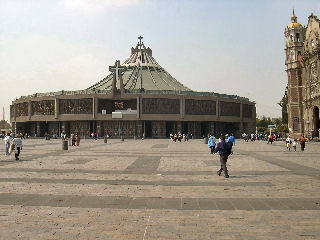
Content Challenge 010: Juan Diego is a Christian. Is this vision of heaven more Christian or more Aztec? Explain.
Picture shows the mountain-shaped XXth-century basilica at the shrine of the Virgin of Guadalupe in the Tepeyac district of Mexico City. The older church building is at the right.
He looked up towards the top of the hill, in the direction from which the sun rises, and where the heavenly song was coming from. But the singing suddenly stopped and could no longer be heard. Instead, he heard someone calling him from the top of the hill, someone saying, “Dearest Juan, Dearest Juan Diego!”
He got up his courage to go to where the voice was coming from. He was not anxious; instead he felt extremely happy and contented. He started to climb to the top of the little hill to go see where he was being called from.
When he reached the top, a lady was standing there. She spoke to him and called to him to come closer to her.
When he reached where she was, he was overwhelmed by the way her perfect grandeur exceeded all imagination: her clothing was shining like the sun, as if it were sending out waves of light; the stone crag on which she stood likewise seemed to be giving out rays of light; her radiance was like precious stones, like an exquisite bracelet; the earth seemed to shine with the brilliance of a rainbow in the mist. The mesquites and nopals and the other little plants that generally grow up there became like emeralds. Their leaves seemed like turquoise. And their trunks, their thorns, their prickles, all glittered like gold.
He knelt down in her presence. He listened to her voice and her words, which were beautiful and extremely kind, as if she were drawing him toward her and esteemed him highly.
She said to him, “My dearest-and-youngest son, Juan. where are you going?”
“My Lady, my Queen, my Beloved Lady!” he answered, “I am going as far as your shrine (chantzintli) in Tlatelolco, to follow the things of God that are given to us and taught to us by the ones who are the representations of Our Lord: our priests.”
Content Challenge 024: Standard Spanish translations of "mochantzinco" here render it as "a tu casita," "to your little house." Yet given how he addresses her, Juan Diego clearly recognizes the Virgin. So is the place really little, or is it palatial? Or beloved? Or is he being polite? How can we tell, or can we?
She answered him and revealed her will, saying to him:
Know, my dearest and youngest son, that I am the Prefect Ever Virgin, Holy Mary, Mother of the one great God of truth who gives us life, the inventor and creator of people, the owner and lord of all that is around us or touching us or very close to us, the owner and lord of the sky, the owner of the earth. I want very much for them to build a shrine for me here, in which I will show, I will make manifest,
I will give to people all my personal love, my compassionate gaze, my help, my salvation, for I am truly the compassionate mother, to you and to all the people who live together in this land, and to all the people of other ancestries who love me, who cry out to me, who seek me, who trust in me. There I shall listen to their weeping and their sadness, I shall remedy and cleanse and nurse all their various troubles, all their miseries, all their suffering.
And to bring about what my compassionate and merciful appearance is trying to accomplish, go to the residence of the bishop of Mexico, and tell him that I am sending you, so that you may reveal to him that I very much want him to build me a dwelling here, to erect a temple for me on the plain [beside the hill]; you will tell him everything, all that you have seen and marveled at, and what you have heard.
And be assured that I will appreciate it very much and reward it, that because of it I will enrich you, I will glorify you; and because of it you will deserve very much the way that I reward your exhausting service in going to request the boon that I am sending you for.
“Now, my dearest son, you have heard my word: go and do what you must with vigor.
Immediately [Juan Diego], kneeling in her presence, said to her, “My Lady, Beloved Lady, I am going now to make your venerable word a reality. I, your poor commoner, am leaving you for a while.”
And then he came down from the hill to put her command into action. He headed for the causeway leading straight into Mexico City.
Go to top
Go to bilingual version
Chapter 2: The Visit to the Bishop & the Second Apparition
When he reached the center of the city, he went straight to the palace of the Bishop, the governing priest, who had just recently arrived. His name was Don Fray Juan de Zumárraga, a Franciscan Priest. As soon as he got there, Juan Diego tried to see him and begged the servants, his helpers, to go and tell him a visitor needed to see him.
After a long time the Reverend Bishop ordered that he be admitted, and they came to call him in. And as soon as he entered, first he knelt down and prostrated himself, then he revealed the precious words of the Queen of Heaven, her message, and he also recounted everything that had made him marvel, the things he had seen and heard.
The bishop listened to his whole story and the message as if he didn’t particularly believe it to be true.
Then he answered him, saying, “My son, you may come again. I will still hear you calmly, I will look at it carefully from the very beginning, I will consider the reason why your have come, your will, your desire.”
Juan Diego left. He was sad, because the errand entrusted to him was not immediately been accepted.
At the end of the day, he returned to Tepeyac and went straight to the top of the little hill. He again had the joy of meeting the Queen of Heaven, for there, exactly where she had appeared to him the fist time, she was waiting for him. As soon as he saw her, he knelt down before her, and as he threw himself to the ground, he said to her:
My dear Mistress, Lady Queen, Youngest Child [of God], my dear Beloved Lady! I did go to where you sent me to carry our your dear commandment; although I entered with difficulty into the place of the Governing Priest, I did see him, and I did put your word, before him, as you ordered me to. He received me kindly and he listened to it carefully, but from the way he answered me, it’s as if he didn’t understand it, as if he didn’t think it was true.
He said to me, “You may come again: I will still listen to you calmly, I will look well to what you have come for from the very beginning, to your desire, your will.”
The way he answered me, I could clearly see that he thinks the house that you want them to build for you here, maybe I’m only making it up, that maybe it is not really from your lips.
I beg you, my Lady, Queen, my Beloved Lady, to have one of the nobles, one who is held in esteem, one who is known, respected, and honored, have him carry your dear word, so that he will be believed. Because I am really (just) a man from the country, I am like a mere [porter’s] rope , a back-frame, a tail, a wing, a man of no importance: I myself need to be led, carried on someone’s back. That place you are sending me to is a place where I’m not used to going to or spending any time in, my Beloved Virgin, my Youngest Daughter of God, my Lady, Beloved Lady. Please excuse me; though I grieve before your face and your heart; I will accept your anger and your displeasure, my Lady, my Mistress.
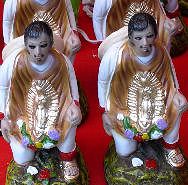
Content Challenge 056: From the perspective of a dramatic narrative, does it make sense to include this scene of Juan Diego's despair and self-doubt and the Virgin's rather severe insistence that he, and only he, must carry out her wish? Why?
Picture shows mass-produced, plastic statues of Juan Diego for sale at the shrine in Tepeyac after he was canonized (sainted) by Pope John Paul II in 2003. He is holding open his cloak, or tilma
, inside which the Virgin's picture has miraculously appeared, as we shall learn in the chapters to follow.
And then the Perfect Virgin, worthy of honor and veneration, answered him as follows:
Listen, my youngest-and-dearest son, and know for sure that I have no lack of servants, of messengers, to whom I can give the task of bearing my word, so that they carry out my will. But it is very necessary that you personally go and plead, that my wish may, become a reality, that it may be carried out through your intercession. I implore you, my youngest-and-dearest son, but I also order you strictly to go again tomorrow to see the bishop. And in my name make him know my will, so that he will bring into being, he will build the house of God that I am asking him for, and carefully tell him again how I, personally, the Ever Virgin Holy Mary, I, who am the Mother of God, am sending you.
Content Challenge 060: nimitztlatlauhtia "I beg you" comes from tlätlauhtia = to beg, implore. Nimitztlacuauhnahuatia = "I order you" comes from tlachuäuh = espcially + nahuatia = to order (pasted into a single word). So is she begging or ordering? Does Juan Diego have free will?
For his part, Juan Diego responded to her and said to her
My Lady, Queen, my Beloved Lady, let me not give you anguish. Let me not grieve you. I will most gladly go to carry out your word. I will absolutely not fail to do it, nor do I think the road is painful. I will go and carry out your will, but perhaps I won’t be heard, and if I am heard, perhaps I won’t be believed. Tomorrow afternoon, when the sun goes down, I will return and tell you how the Governing Priest answers me. For now, I respectfully say goodbye to you, my youngest Daughter of God, my Virgin, Lady, Lady, [so that I may] rest a little.
And with that he went to his house to rest.
Go to top
Go to bilingual version
Chapter 3: The Second Visit to the Bishop
On the following day, Sunday, while it was still night and everything was still dark, Juan Diego left his house and went straight to Tlatelolco to [attend mass in order to] learn what pertained to God, to be counted in roll call, and then to see the Reverend Bishop.
Around ten o’clock everything had been taken care of: Mass was over and roll had been called and the crowd had gone away. Juan Diego went to the Reverend Bishop’s residence.
As soon as he arrived, he went through the same whole struggle to see him, and after much effort he saw him again. He knelt at his feet, he wept and became sad as he spoke to him, as he revealed to him the words, of the Queen of Heaven, that the errand, the will, of the Perfect Virgin should be believed, to make for her a little shrine, where she had said she wanted it.
The Reverend Bishop asked him many, many things and pursued many, many, questions with him, to make certain of where he had seen her and what she was like. He told absolutely everything to the Reverend Bishop.
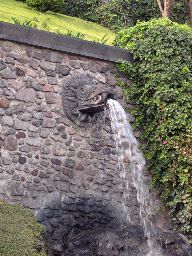
Content Challenge 074: The Nahuatl text varies between "tlatoani obispo" ("lord bishop") and "teopixca-tlatoani" ("lord of priests") for Bishop Zumárraga. The term "tlatoani" has a long history in Nahuatl. It originally seems to have meant "speaker" or "spokesman," but in pre-Christian times it was used, perhaps principally, to refer to the Aztec "emperor." Why is it applied to the Bishop? Is "Señor" a useful English translation? Why (not)? In the present translation the bishop has been called a "governing priest" when he is teopixca-tlatoani, "Reverend Bishop" elsewhere. Is that any better? What are other possibilities?
The picture shows the spring at the shrine of the Virgin of Guadalupe at Tepeyac flowing out of the mouth of the god Quetzalcoatl, as modeled on his representation at the Classic Era shrine site of the Citadel at Teotihuacan. What should we make of this continuing use of the image of the ancient "feathered serpent god" at a modern Catholic shrine?
But although Juan Diego told him absolutely everything, and stressed that, in everything, he saw, it appeared with absolute clarity that she indeed was the Perfect Virgin, the kind and wondrous mother of our savior, our lord Jesus Christ, nevertheless he still was not believed. The Reverend Bishop said that his could petition could not be carried out simply on the basis of Juan Diego’s word and what he requested to have happen. Rather, some additional sign would be necessary if people were really to believe that the Queen of Heaven in person was sending him.
As soon as Juan Diego heard that, he said to the Bishop: “Señor Governor, think about what the sign you ask for will be, because then I will go to ask for it from the Queen of Heaven who sent me.”
Content Challenge 080: Isn't Juan Diego going out on a limb with this promise? Did the Virgin really say he could promise a sign on her behalf?
When the Bishop saw that he was in agreement, that he did not hesitate or doubt in the slightest, he dismisses him. But as soon as Juan Diego on his way, the Bishop ordered some of household staff in whom he had absolute trust to follow him and carefully observe where he was going, whom he was seeing, to whom he was talking. And that’s what they did. Juan Diego came directly back [to Tepeyac] on the causeway.
Go to top
Go to bilingual version
Chapter 4: The Third Apparition
Those who were following Juan Diego lost him on the wooden bridge where the brook comes out near Tepeyac. And even though they searched all over for him, they couldn’t find him anywhere. So they turned back. It made them angry, not just because they had made terrible fools of themselves, but also because he had frustrated their attempt. Therefore they went to tell the Reverend Bishop, and they put it into his head that he shouldn’t believe [Juan Diego]; they told him how he was only telling lies, that he was only making up what he came say, or that he was only dreaming, only imagining what he was reporting and what he was asking be done.
They also decided that if he came back, they would seize him and punish him severely, so that he would never come again to tell lies or get the people all excited.
Meanwhile, Juan Diego was with the Most Holy Virgin, telling her the response that he was bringing from the Reverend Bishop.
When she had heard it, she said to him:
That’s fine, my dear son, you will come back here tomorrow so that you may take the bishop the sign he has asked you for. With this he will believe you. He will no longer have any doubts about all this, and he will no longer be suspicious of you. And know, my dear son, that I will reward all the care and work and exhaustion that you have put into this for me. So, go now. I will be waiting for you here tomorrow.
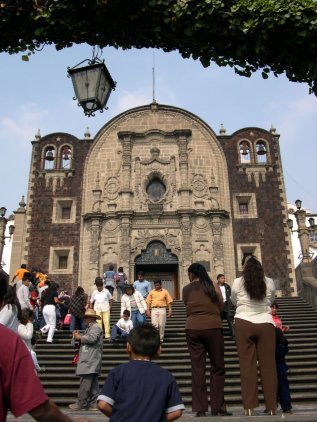
Content Challenge 094: From the perspective of a dramatic narrative, what purpose is served, if any, for the Virgin to have Juan Diego return the next day rather than providing him with a sign immediately?
Picture shows pilgrims at the Shrine at Tepeyac
On the following day, Monday, when Juan Diego was to carry some sign in order to be believed, he did not return to Tepeyac because, when he had arrived at his house in Cuauhtitlán, a sickness had struck an uncle of his, named Juan Bernardino, who had fallen very ill.
He had gone to get a native healer, who had treated him, but it was too late; he was very ill.
Night came and shortly after midnight, Juan Diego’s uncle begged him to go, while it was still dark, to Tlatelolco for some priest to confess him, to go to get him ready because he was sure that this was the time and place for him to die. He could no longer get up. He would no longer get well.
And so on Tuesday morning, while it was still dark, Juan Diego left his house to go to Tlatelolco to get the priest.
When he reached the little hill [of Tepeyac] which ended the mountain range, at its foot, where the road comes out, on the side where the sun set, where he always passed before, he said to himself, “If I go ahead on the road, I won’t want the Lady to see me, because for sure, just like before, she’ll stop me so I can take the sign to the bishop for her, as she ordered me to. But first our tribulation must leave us; first I must quickly summon Father Motolinía; my uncle is anxiously waiting for him.”
Content Challenge 102: Juan Diego wants to obey the Virgin, but he also needs to see to the needs of his dying uncle, and both seem to demand attention simultaneously. What should his priorities be? Why? Does he do this right?
Immediately he turned toward the hill, climbed across it where there was a pass, and came out on the eastern side, so that he could go quickly to Tlatelolco without the Queen of Heaven detaining him. He imagined that where he made the turn, she who is sees all things everywhere wouldn’t be able to see him.
Go to top
Go to bilingual version
Chapter 5: The Fourth Apparition
Suddenly he saw her coming down from atop the hill; she had been watching him from up there, from where she had seen him before. She came to meet him beside the hill, blocked his way; and said to him: “Where are you going, my youngest-and-dearest son? Where are you headed?”
Perhaps because of his grief, or of his shame, or of his fear of the situation, he became fearful. He prostrated himself before her, greeted her, and said:
“My little Lady, youngest Daughter [of God], my Virgin! I hope you are happy; how are you this morning? Does your beloved body feel well, my Lady, my Gracious Lady?
Although I will cause your face and your heart anguish, I must tell you, my Beloved Lady, that one of your servants, my uncle, is very ill. A terrible sickness has taken hold of him; he will surely die from it soon. And now I shall go quickly to your shrine in [the city of] Mexico-Tlatelolco, to call one of our priests, the beloved ones of Our Lord, so that he will go to hear his confession and prepare him, for we really were born for that, we who come [into the world] only to wait for the painful effort of our death.
But, when I have carried it out [this errand], I will return here to go carry your word, my Lady, my Lady. I beg you to forgive me, to be patient with me a little longer, because I am not deceiving you in this, my youngest Daughter, my Beloved Lady. Tomorrow without fail I will come here as soon as possible.
As soon as she heard Juan Diego’s explanation, the Merciful Perfect Virgin answered him:
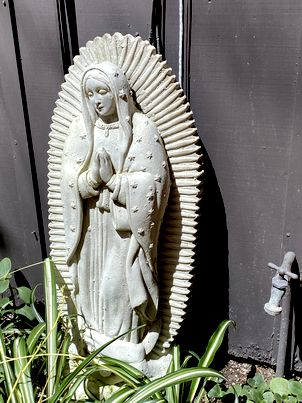
Content Challenge 117: Juan Diego has been disobedient and is effectively telling the Virgin that the dog ate his homework. How do you predict she will react? Why? Imagine your answer before you read on. Then, in light of what she actually does, how surprising was it? From the perspective of a narrative account, how interesting is her reaction? What does this encounter tell us about Juan Diego and about the Virgin?
The picture shows the Virgin of Guadalupe sold for use as a concrete "garden gnome." How should this be understood? Does it suggest affection? Intimacy? Respect? Irreverence?
Listen! Put it into your heart, my youngest-and-dearest son, that the thing that frightens and afflicts you is nothing. Do not let it disturb you. Do not fear this sickness nor any other sickness, nor any sharp and hurtful thing. Am I not here, I, who am your mother? Are you not under my shadow and protection? Am I not the source of your joy? Are you not in the hollow of my mantle, in the crossing of my arms? Do you need something more? Do not let anything else worry or disturb you. Do not let your uncle’s illness pressure you with grief, because he will not die of it now. You may be certain that he is already well.
Historical Note: The first question in this series, "Am I not here, I, who am your mother?" Cuix amo nican nica nimonantzin? has become perhaps the most widely known Nahuatl expression among non-Nahuatl speakers in Mexico, and one finds it worked into paintings and other decorative contexts wherever the Virgin of Guadalupe is revered.
Historical Note: The first question in this series, "Am I not here, I, who am your mother?" Cuix amo nican nica nimonantzin? has become perhaps the most widely known Nahuatl expression among non-Nahuatl speakers in Mexico, and one finds it worked into paintings and other decorative contexts wherever the Virgin of Guadalupe is revered.
And at that very moment his uncle regained his health, as they later found out.
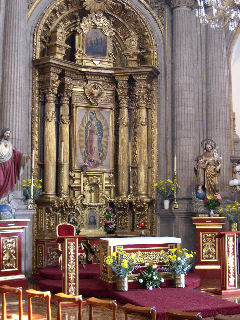
Content Challenge 121: Based on the text so far, do you think the Virgin healed Juan Diego's uncle or merely had knowledge that he was naturally recovering? What is the interpretation that is put upon the Juan Bernardino's illness by the end of the text?
The picture shows the altar of El Pocito, one of the older churches in the Tepeyac compound, and similar in general appearance to many churches throughout the country. The picture over the altar is a copy of the tilma hanging over the alter of the nearby modern basilica.
When Juan Diego heard the blessed words of the Queen of Heaven, he was greatly comforted by them, and his heart became peaceful. He begged her to send him immediately to see the Reverend Bishop, to take him something to him as a sign, as the proof so that he would believe.
The Queen of Heaven ordered him to go to the top of the little hill, where he had seen her before. She said to him, “Go up, my dearest son, to the top of the hill, to where you first saw me and where I told you what to do. There you will see that there are different kinds of flowers. Cut them, gather them, put them all together, then come down here. Bring them here, into my presence.”
Juan Diego climbed to the top the top of the hill right away. And when he reached the top, he was astonished by all of the blooming, open flowers, flowers of every kind, lovely and beautiful, even though it still was not their season. In fact, it was the season in which the frost was very harsh.
They were giving off a lovely, extremely soft fragrance and looked like precious pearls, as if filled with the dew of the night. He began to cut them. He gathered them all, he put them in the hollow of his cloak (tilma).
The top of the little hill is certainly not a place in which any flowers normally grow; there are only plenty of rocks, thorns, spines, prickly pears and mesquite trees. And even though some little herbs or grasses might grow, it was then the month of December, in which the frost eats everything up and destroys it.
As soon as he came back down, he brought the Heavenly Lady the different kinds of flowers which he had gone up to cut. And when she saw them, she took them with her precious hands. Then she put them all together into the hollow of his cloak again and said:
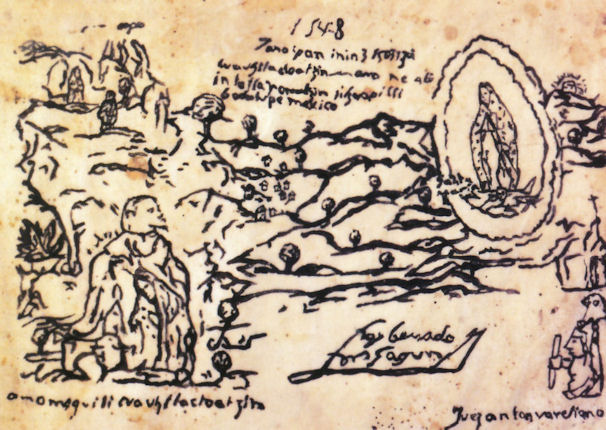
Juan Diego Receives the Flowers
Codex 1548
My youngest-and-dearest son, these different kinds of flowers are the proof, the sign that you will take to the bishop. You will tell him from me that he is to see my desire in them, and that therefore he is to carry out my wish, my will. And you, you who are my messenger, in you I place my absolute trust.
Also, I strictly order you to open your cloak only alone in the presence of the bishop to show him what you are carrying. And you will tell him everything exactly. You will tell him that I ordered you to climb to the top of the little hill to cut flowers, and everything that you saw and admired there, so that you can convince the Reverend Bishop to do what lies within his responsibility so that the temple which I have asked him for will be raised up.
As soon as the Queen of Heaven gave him her orders, he took the causeway straight to Mexico City, happy now. His heart was tranquil now, because his errand would come out well, he would carry it our perfectly. Along the way, he was very careful of what was in the hollow of his cloak, lest he lose anything. But as he went along, he enjoyed the fragrance of the different kinds of exquisite flowers.
Go to top
Go to bilingual version
Chapter 6: The Third Visit to the Bishop
When Juan Diego arrived at the Bishop’s residence, the doorkeeper and the other servants of the Reverend Bishop went to confront him. He begged them to tell the Reverend Bishop how much he wanted to see him, but they were not willing. They pretended they didn’t understand him, perhaps because it was still very dark, or perhaps because they felt by now that all he did was to bother them by his constant insisting. Their companions had already told them how they had lost him from sight when they were following him. So for a long, long time he waited for his request to be granted.
When they saw that he was simply standing there for a long, long time with his head down, without doing anything, waiting in case he should be called, and that it looked as if he was carrying something in the hollow of his cloak, then they came up close to him to see what he was bringing and thus satisfy their curiosity.
Juan Diego saw that there was no way in which he could hide from them what he was carrying and that they might harass him or push him perhaps hurt both him and the flowers, he finally gave them a little peek and they saw that it was flowers. When they saw that they were all exquisite different flowers, even though it wasn’t the season for them to be blooming, they were very, very astonished by how fresh they were, how good they smelled, how handsome they seemed. And they wanted to grab and pull a few out.
Three times they made bold to try to grab them, but there was no way in which they could do it because, whenever they tried, they could no longer see the flowers themselves, but saw them only as if they were painted or embroidered or sewn on the cloak.
They went immediately to tell the Reverend Bishop what they had seen and how much the lowly commoner, who had already come previous times, wanted to see him, and that he had been waiting a very long time there for permission, because he wanted to see him.
As soon as the Reverend Bishop heard it, he realized that this was going to be the proof to convince him to get started on what the humble man was asking him for. He immediately ordered that he be shown in.
Content Challenge 161: The Bishop has been an unbeliever so far, and Juan Diego has had to go back to the Virgin empty-handed twice because of the Bishop's lack of faith. Suddenly he seems far more sympathetic. Has he changed, or has he in fact been consistent? If he has changed, how do we understand the change? For example, has the Virgin exerted quiet influence on him not directly mentioned in the text? Or has he become curious, or weary? What makes sense from the standpoint of the flow of the narrative?
When [Juan Diego] had come in, he knelt in [the Bishop’s] presence, as he had done before. And again he told him what he had seen and admired, and delivered his message. Then he said:
Your Excellency, sir! I have done it. I have carried out your orders. That is, I went to tell my Mistress, the Queen of Heaven, Holy Mary, the Beloved Mother of God, that you were asking for proof so you could believe me, so that you would make her a shrine where she was asking you to build it. And I also told her that I had given you my word to come to bring you some sign, some proof of her will, just as you told me to. And she listened carefully to your word, and was pleased to receive your request for the sign, so that her beloved will could be carried out.
Content Challenge 167: She was pleased? If so, why?
Today, while it was still dark, she ordered me to come again to see you. I asked her for the proof so that I would be believed, as she said that she would give it to me, and she kept her promise immediately. And she ordered me to the top of the little hill where I had seen her before, to cut different flowers up there, even Castilian roses.
When I had cut them, I was to take them down to her at the bottom; and she would take them with her holy hands, then return them to the hollow of my cloak so that I could bring them to you, and only to you.
Although I know very well that the top of the hill isn’t a place where flowers grow, because there are only a lot of craggy rocks, thorns, spiny acacias, prickly pears, and mesquite bushes, I didn’t doubt her or hesitate because of that. When I reached the top of the hill I saw that it was now a paradise. All kinds of different precious flowers were there, each one perfect, the very finest that there are, full of dew and shining. And so I immediately cut them.
She told me that I should give them to you from her, and that in this way I would show the truth and that your would see the sign that you were asking for in order to carry out her beloved will. It should now be clear that my message is true. Here they are; please receive them.
And then he opened out his white cloak, in the hollow of which he had placed the flowers.
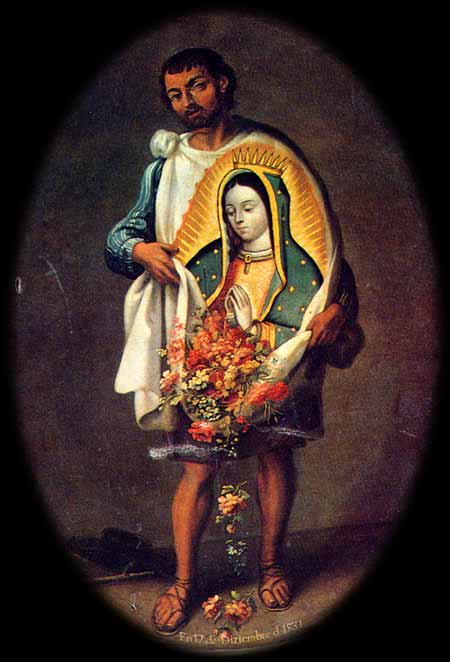
Content Challenge 182: In lines 126, 127, 134, 153, 154, and 157 we were told that Juan Diego found and collected many kinds of (exquisite) flowers —nepäpan (tlazoh-) xöchitl.
But in lines 175, 176, and 181, they are specifically Castilian roses —caxtillan xöchitl— and in line 182 they are specifically
many different kinds of Castilian roses —nepäpan caxtillan xöchitl.
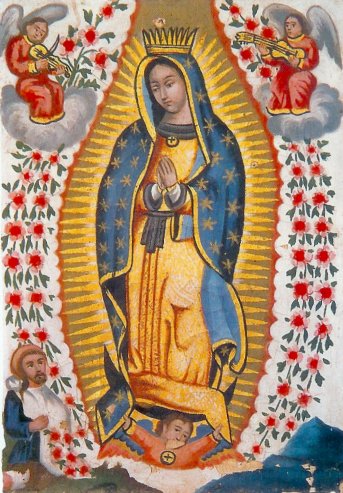
Thus even in the text the flowers have evolved from many kinds of
flowers to many kinds of
Castilian roses. Some artists, like the one at left, show many different kinds of flowers, others various colors of roses, and some artists, like the one on the right, limit themselves to red roses only.
Is this inconsistency simply an error in Valeriano's account? Or is it somehow part of the story (perhaps the trace of a tradition that is not otherwise represented in this text)? What is the best way for an artist to deal with the problem?
(Thanks to Karandeep Singh, class of 2021, Eleanor Roosevelt College, UCSD, for pointing out this problem.)
And just as all the different kinds of Castilian roses [and other flowers] fell out upon the floor, then and there, the beloved Image of the Perfect Virgin, Holy Mary, Mother of God, became the sign, for it suddenly appeared [painted inside the cloak] in the form and figure in which it has now, where it is preserved in her beloved shrine, at Tepeyac, which is called Guadalupe.
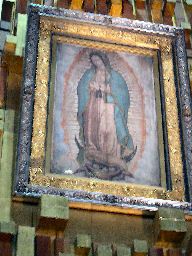
Content Challenge 184: The narrator interrupts his flow of events just at this climactic moment by referring to the fact that the tilma is still extent and is in "her sacred little house at Tepeyac, which is called Guadalupe." What narrative purpose, if any, is served by that interruption? Explain.
Picture: The Tilma Behind Bulletproof Glass in Its Shrine Today
As soon as the Reverend Bishop and all those who were there saw it, they knelt, for they were full of awe and reverence. They stood up to see it, they became sad, they wept, and then their hearts and minds were in ecstasy.
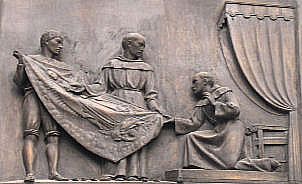
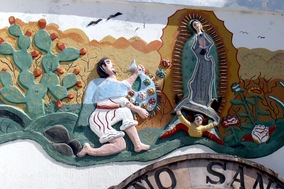
Bas Relief on the Façade of the Shrine Church at
Tepeyac (left) and the Parish Church of Cupilco (right)
The Reverend Bishop, weeping with sadness, begged her to forgive him for not having immediately carried out her will, her holy word. When he got off his knees, he untied Juan Diego’s cloak from his neck where it was tied, and on which the Queen of Heaven appeared, on which she had become the sign, [190] and he placed it in his private chapel. Juan Diego stayed for the day in the Bishop’s house, who kept him there. The next day he said to him, “Come, let’s go so you can show where it is that the Queen of Heaven wants her temple built.” And people were immediately invited to begin building it.
Historical Note: The appearance of the roses might have been enough to convince Bishop Zumárraga of the reality of Juan Diego's vision, but the appearance of the Virgin's image inside Juan Diego's cloak provided a lasting object of veneration.
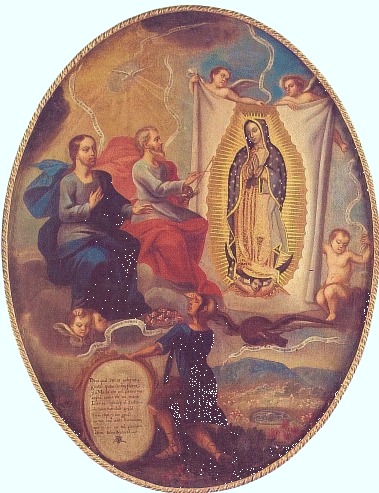
Despite skeptics, both in the past and today, the painting on the tilma is widely considered to be of miraculous origin. In this XVIIIth-century representation by Joaquín Villegas, now hanging in the Museo Nacional de Arte, we see great literalism as God the Father (accompanied by Jesus at the left and the holy spirit as a dove hovering overhead) wields a paintbrush while putti hold up the tilma to facilitate his work.
The miraculous quality of the image continues to be an aticle of faith today. In the XXth century, some claimed to see a "miraculous photograph" of Juan Diego as a reflection in the pupil of the Virgin's eye on the tilma. This has been taken to suggest that the image came into being as a kind of "photograph" of the Virgin as she looked at Juan Diego. Others see a second or even a third image in the pupil and have argued that they are Juan Gonzáles (Bishop Zumárraga's Nahuatl interpreter) and either the bishop or the Virgin herself (invisible to the human occupants of the chamber), suggesting that the image was formed in a split second just as the tilma was opened.
Go to top
Go to bilingual version
Chapter 7: The Story of Uncle Juan Bernardino
As soon as he showed the Bishop where the Lady of Heaven had ordered that her shrine be built, Juan Diego asked permission to return home in order to see his uncle, Juan Bernardino, who had been very ill when he left him to go to Tlatelolco to call a priest to confess him and prepare him, the same uncle whom the Queen of Heaven had told him had already been cured.
But they didn’t let him go alone; rather, people went with him to his house. When they arrived, they saw that his uncle was now healthy and nothing afflicted him. Mostly, he was very surprised by the way in which his nephew was being accompanied and honored.
He asked his nephew why it was that so much honor was being paid to him, and his nephew told him about how he had left to go call a priest to come and confess him and prepare him, and how the Lady of Heaven had appeared to him over at Tepeyac and sent him to Mexico-Tlatelolco to see the Reverend Bishop so that he would make her a shrine at Tepeyac, and how she had told him not to worry because his uncle was now well, and how she consoled him very much with this news.
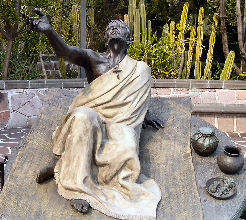
Uncle Juan Bernardino's Statue at Tepeyac
His uncle replied that it was true, that she had healed him at that exact moment, , and that he had seen her in exactly the same way that she had appeared to his nephew, and that she had told him that she was sending him to Mexico-Tlatelolco to see the Bishop. She also told him that when he [Uncle Bernardino] saw the Bishop, he should reveal absolutely everything to him and tell him what he had seen and the marvelous way in which she had healed him. Also that he [the Bishop] should properly name her beloved image [in Juan Diego’s cloak] “The Perfect Virgin, Santa Maria de Guadalupe.”
And so they brought Uncle Juan Bernardino into the presence of the Reverend Bishop so that he could speak to him and give his testimony, and together with his nephew Juan Diego, the Bishop lodged them in his house for several days while the shrine of the Queen was built out there at Tepeyac, at the place where she had revealed herself to Juan Diego.
The Reverend Bishop himself moved the beautiful image of the Beloved Heavenly Lady [on the cloak] to the Iglesia Mayor. He took the beloved image out of the private chapel in his residence where it had been, so that all could see it and admire it.
The entire city, everyone without exception, was deeply moved as everyone turned out to see and admire her holy image, to acknowledge its divine nature, and to offer her their prayers.
All marveled at the miraculous way it had appeared, since no earthly hand had painted the beloved image.

Content Challenge 218. The text stops here, although other, later traditions tell us that Juan Diego eventually moved to the new shrine, where he spent the rest of his life as a caretaker. We learn little more of the Bishop or of Uncle Juan Bernardino or of the roses, and the Virgin does not reappear once she has her shrine. From the perspective of a literary narrative, does the narration end in the right place? If you could add three more lines (real or fictional), how would you add to the text?
The picture shows the display of a religious wares peddler near the Shrine to the Virgin of Guadalupe at Tepeyac in Mexico City.
Followup Note: Each day of the year is a “feast day” of several saints, either officially recognized by the Catholic or Anglican Church (or other Christian churches) or venerated locally but without official recognition. The Virgin of Guadalupe is venerated on December 12 and Juan Diego (sainted in 2002) on December 9.
In Mexico December 12 begins el maratón Guadalupe-Reyes, which extends to the Día de Reyes (the Feast of Saint Balthazar) on January 6, which is linked to the tradition of the “wise men from the east” who came to Bethlehem bearing gifts to the baby Jesus. (Click here for more.)
Go to top
Go to Introduction
 Content Challenge 010: Juan Diego is a Christian. Is this vision of heaven more Christian or more Aztec? Explain.
Content Challenge 010: Juan Diego is a Christian. Is this vision of heaven more Christian or more Aztec? Explain.

 Content Challenge 056: From the perspective of a dramatic narrative, does it make sense to include this scene of Juan Diego's despair and self-doubt and the Virgin's rather severe insistence that he, and only he, must carry out her wish? Why?
Content Challenge 056: From the perspective of a dramatic narrative, does it make sense to include this scene of Juan Diego's despair and self-doubt and the Virgin's rather severe insistence that he, and only he, must carry out her wish? Why? Content Challenge 074: The Nahuatl text varies between "tlatoani obispo" ("lord bishop") and "teopixca-tlatoani" ("lord of priests") for Bishop Zumárraga. The term "tlatoani" has a long history in Nahuatl. It originally seems to have meant "speaker" or "spokesman," but in pre-Christian times it was used, perhaps principally, to refer to the Aztec "emperor." Why is it applied to the Bishop? Is "Señor" a useful English translation? Why (not)? In the present translation the bishop has been called a "governing priest" when he is teopixca-tlatoani, "Reverend Bishop" elsewhere. Is that any better? What are other possibilities?
Content Challenge 074: The Nahuatl text varies between "tlatoani obispo" ("lord bishop") and "teopixca-tlatoani" ("lord of priests") for Bishop Zumárraga. The term "tlatoani" has a long history in Nahuatl. It originally seems to have meant "speaker" or "spokesman," but in pre-Christian times it was used, perhaps principally, to refer to the Aztec "emperor." Why is it applied to the Bishop? Is "Señor" a useful English translation? Why (not)? In the present translation the bishop has been called a "governing priest" when he is teopixca-tlatoani, "Reverend Bishop" elsewhere. Is that any better? What are other possibilities?
 Content Challenge 094: From the perspective of a dramatic narrative, what purpose is served, if any, for the Virgin to have Juan Diego return the next day rather than providing him with a sign immediately?
Content Challenge 094: From the perspective of a dramatic narrative, what purpose is served, if any, for the Virgin to have Juan Diego return the next day rather than providing him with a sign immediately?
 Content Challenge 117: Juan Diego has been disobedient and is effectively telling the Virgin that the dog ate his homework. How do you predict she will react? Why? Imagine your answer before you read on. Then, in light of what she actually does, how surprising was it? From the perspective of a narrative account, how interesting is her reaction? What does this encounter tell us about Juan Diego and about the Virgin?
Content Challenge 117: Juan Diego has been disobedient and is effectively telling the Virgin that the dog ate his homework. How do you predict she will react? Why? Imagine your answer before you read on. Then, in light of what she actually does, how surprising was it? From the perspective of a narrative account, how interesting is her reaction? What does this encounter tell us about Juan Diego and about the Virgin? Content Challenge 121: Based on the text so far, do you think the Virgin healed Juan Diego's uncle or merely had knowledge that he was naturally recovering? What is the interpretation that is put upon the Juan Bernardino's illness by the end of the text?
Content Challenge 121: Based on the text so far, do you think the Virgin healed Juan Diego's uncle or merely had knowledge that he was naturally recovering? What is the interpretation that is put upon the Juan Bernardino's illness by the end of the text?

 Content Challenge 182: In lines 126, 127, 134, 153, 154, and 157 we were told that Juan Diego found and collected many kinds of (exquisite) flowers —nepäpan (tlazoh-) xöchitl.
Content Challenge 182: In lines 126, 127, 134, 153, 154, and 157 we were told that Juan Diego found and collected many kinds of (exquisite) flowers —nepäpan (tlazoh-) xöchitl. 
 Content Challenge 184: The narrator interrupts his flow of events just at this climactic moment by referring to the fact that the tilma is still extent and is in "her sacred little house at Tepeyac, which is called Guadalupe." What narrative purpose, if any, is served by that interruption? Explain.
Content Challenge 184: The narrator interrupts his flow of events just at this climactic moment by referring to the fact that the tilma is still extent and is in "her sacred little house at Tepeyac, which is called Guadalupe." What narrative purpose, if any, is served by that interruption? Explain.

 Despite skeptics, both in the past and today, the painting on the tilma is widely considered to be of miraculous origin. In this XVIIIth-century representation by Joaquín Villegas, now hanging in the Museo Nacional de Arte, we see great literalism as God the Father (accompanied by Jesus at the left and the holy spirit as a dove hovering overhead) wields a paintbrush while putti hold up the tilma to facilitate his work.
Despite skeptics, both in the past and today, the painting on the tilma is widely considered to be of miraculous origin. In this XVIIIth-century representation by Joaquín Villegas, now hanging in the Museo Nacional de Arte, we see great literalism as God the Father (accompanied by Jesus at the left and the holy spirit as a dove hovering overhead) wields a paintbrush while putti hold up the tilma to facilitate his work. 
 Content Challenge 218. The text stops here, although other, later traditions tell us that Juan Diego eventually moved to the new shrine, where he spent the rest of his life as a caretaker. We learn little more of the Bishop or of Uncle Juan Bernardino or of the roses, and the Virgin does not reappear once she has her shrine. From the perspective of a literary narrative, does the narration end in the right place? If you could add three more lines (real or fictional), how would you add to the text?
Content Challenge 218. The text stops here, although other, later traditions tell us that Juan Diego eventually moved to the new shrine, where he spent the rest of his life as a caretaker. We learn little more of the Bishop or of Uncle Juan Bernardino or of the roses, and the Virgin does not reappear once she has her shrine. From the perspective of a literary narrative, does the narration end in the right place? If you could add three more lines (real or fictional), how would you add to the text?